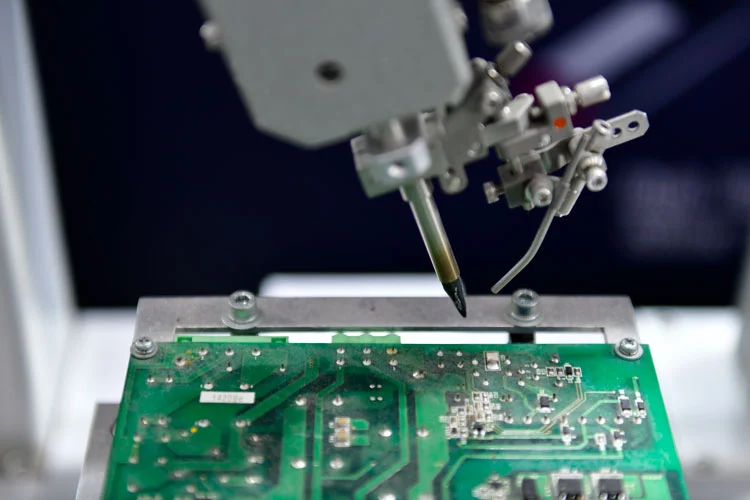Printed Circuit Board Tape
What is a Printed Circuit Board?

Printed circuit boards, abbreviated as PCBs, are the foundational building block for most electronics manufacturing. A high-density, high-speed circuit board may be used in supercomputers and servers. Printed circuit boards are the foundation on which all other electronic products are assembled.
PCBs have mechanical and electrical components that make them ideal for electronic applications. Most PCBs manufactured are rigid, but some PCBs are flexible, allowing the circuits to be bent and folded into shape without any break in the circuits. These flexible PCBs comprise roughly 10% of the market.
A small subset of these types of circuits is called rigid-flex circuits, where one part of the board is rigid and one or more parts are flexible, providing the advantages of flexible circuits listed above.
What are PCBs made of?

Typically, PCBs are made from non-substrate materials with layers of copper circuitry. PCBs can be single-sided (one copper layer), double-sided (two copper layers on both sides of one substrate layer), or multi-layer (outer and inner layers of copper, alternating with layers of the substrate). A multi-layer PCB allows for much higher component density because circuit traces on the inner layers would otherwise take up surface space between components.
PCBs are also typically comprised of bonding and protective elements, such as rubber adhesive, polyimide film, polyester film, or blended silicone to help the board withstand high temperature and a variety of other stressors.
The rise in popularity of multilayer PCBs with more than two, and especially with more than four, copper planes was concurrent with the adoption of surface mount technology. However, having a multilayer printed circuit board makes the repair, analysis, and field modification of circuits much more difficult and often impractical.
Wave Soldering Process
Wave soldering is a bulk soldering process used for the manufacturing of printed circuit boards. The circuit board is passed over a pan of high temperature, molten solder in which a pump produces an upwelling of solder that looks like a standing wave. As the circuit board makes contact with this wave, the components become soldered to the board.
Wave soldering is used for both through-hole printed circuit assemblies and surface mounts. In the latter case, the components are glued onto the surface of a printed circuit board by placement equipment, before being run through high-temperature applications like the molten solder wave. Wave soldering is mainly used in the soldering of through-hole components.
As through-hole components have been largely replaced by surface mount components, wave soldering has been supplanted by reflow soldering methods in many large-scale electronics applications. However, there is still significant wave soldering where surface-mount technology is unavailable or not suitable, such as with the assembly of large power devices.
Why Mask a Printed Circuit Board?
Printed circuit boards have connectors, test sites, and pins where electrical continuity needs to be maintained, which means conformal coating can not be applied to those specific points. There are also other points of a board that needs to be masked, such as unsealed components (like relays or open inductors), through holes, and even LED surfaces where light output may be impacted by the coating.
Masking tape for a Printed Circuit Board

Low-ESD Polyimide Tape
The ideal tape for masking printed circuit boards is the low ESD (Electrostatic Discharge) polyimide tape. The low ESD function reduces the discharge of electroplating static upon the tape’s removal. Low ESD polyimide also adheres strongly without leaving behind residue on the gold fingers or other components of the circuit board.
Crepe Masking Tape
Another great option for printed circuit board tape is crepe masking tape. It has the lowest price and less risk of static damage compared to polyester tapes. The drawback to this option is that it’s not as flexible as polyimide, so won’t conform as well. An additional benefit of crepe tape is that it uses a rubber-based adhesive instead of silicone, helping reduce the rise of silicone residue remaining on the board.
Polyimide Tapes
Another very popular and effective choice for masking printed circuit boards is standard polyimide tape. Polyimide tape is flexible, doesn’t leave behind any residue, has very high-heat resistance, and comes in a variety of different sizes.
PCB Masking with BF&S

End your search for PCB masking with BF&S. BF&S services the Aerospace, Medical, Military, and Industrial fields with the manufacturing process and parts they need with an unmatched standard of quality and reliability.
Founded in 1988, BF&S has decades of experience manufacturing in Mexico, with over 500 employees in the state of Sonora. Our warehousing and corporate offices are located in Douglas and we are incorporated in the state of Arizona. The BF&S executive team was born and raised in the United States and runs our organization with U.S management standards and practices.
